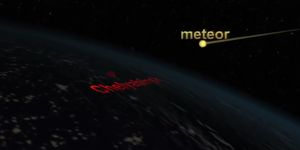Were There Originally Three Magellanic Clouds?
Astronomers recognize the Large and Small Magellanic Clouds as some of the closest galaxies to the Milky Way, but could there have been a third Magellanic cloud at some point in the past?
Image Credit:
New research published this week in the Monthly Notices of the Royal Astronomic Society mentions that, based upon peculiar circumstances present in the Large Magellanic Cloud, there indeed could have been.
Citing study lead author Benjamin Armstrong from the International Centre for Radio Astronomy Research (ICRAR), the stars in the Large Magellanic Cloud move in strange ways. More specifically, some of those stars rotate clockwise, while others rotate counter-clockwise.
Furthermore, the Large Magellanic Cloud is comprised of two distinct types of star clusters: some full of younger stars, and some full of older stars. There isn’t much in the middle to speak of, causing what some astronomers refer to as the “age gap.”
It’s somewhat unusual for stars in a galaxy to exhibit disagreements of this nature, but not if a merger transpired. That said, a third galaxy may have merged with what we call the Large Magellanic Cloud today between three and five billion years ago, resulting in these bizarre circumstances.
"For a while, it was thought that these stars might have come from its companion galaxy, the Small Magellanic Cloud," Armstrong explained. "Our idea was that these stars might have come from a merger with another galaxy in the past."
Related: Two behemoth galaxies from the early universe are merging
With the help of computer modeling software, the researchers replicated a merger that resulted in the same phenomenon observed in the Large Magellanic Cloud. Albeit not substitutes for real-world observations, computer models help provide validation for theories that otherwise can’t be directly proven, like this one.
"Our work is still very preliminary but it does suggest that this sort of process could have been responsible for the thicker disk in the past," Armstrong added. "It's about creating a new idea, a new way of looking at an old problem."
Related: Astronomers say these are the oldest galaxies in the universe
As Armstrong points out, the results aren’t conclusive. But they are a starting point for astronomers to understand the unique circumstances in the Large Magellanic Cloud that have gone unexplained for eons. Future studies may refute these findings as new findings emerge, but only time will tell.
Source: Phys.org, Monthly Notices of the Royal Astronomical Society, Wikipedia









